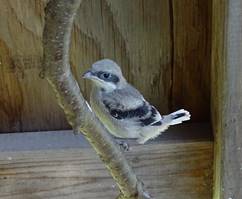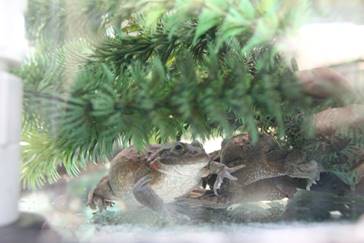
Toronto Zoo Conservation Breeding Programs Update
Zoo Successfully Breeds Critically Endangered Vancouver Island Marmots, and Endangered Eastern Loggerhead Shrikes and Oregon Spotted Frogs


Photo credit: Toronto Zoo
TORONTO, ON, Monday, June 12, 2017
Vancouver Island Marmots
The Toronto Zoo is proud to announce the births of three Vancouver Island marmot pups born on May 20, 2017 to parents Oban and River. This is the 35th litter and a total of 127 marmot pups born at the Toronto Zoo, with most being released into the wild on Vancouver Island.
The Vancouver Island marmot (VIM), is one of the most critically endangered animals in the world, and is Canada's most endangered mammal. The Toronto Zoo has been participating in the captive breeding program for the Vancouver Island marmot since 1997, when it was first approached by the Marmot Recovery Foundation to begin a captive breeding and release program. This marmot species is only one of six mammals endemic to Canada and was North America’s most endangered mammal in 2003, when there were only 30 individuals left in the wild.
Because of significant captive breeding efforts, including the Toronto Zoo's, the wild population has steadily grown. The Toronto Zoo has also been involved in many research projects to help increase our understanding of this unique mammal and has spearheaded studies on mating behaviour, pup development and hormone analysis for monitoring reproductive cycles of breeding females. This research has been vital to ensure that the VIM experiences a triumphant return to the wild.
“The birth of these pups and the conservation breeding efforts that take place at the Toronto Zoo are paramount to saving Canadas’s critically endangered species like the Vancouver Island marmot”, said Maria Franke, Curator of Mammals.
*Please note, the Vancouver Island marmot pups are not viewable to the public or media.
Vancouver Island Marmot Captive Breeding Program
Eastern Loggerhead Shrikes Births
In 1997, the wild population of Eastern loggerhead shrikes in Canada had decreased to only 18 known pairs. At that time, 43 nestlings were collected from wild nests in Ontario to found a captive population and rebuild the population of this species at risk.
Today the Toronto Zoo provided an update on the Eastern loggerhead shrike conservation breeding program with thirteen fledglings (young that have left their nests) and 6 nestlings (young still in the nest and an additional 17 eggs that have yet to hatch.
Over the last two decades, more than 215 young have been hatched out at the Toronto Zoo with the majority being released to the wild. Last year alone, the Toronto Zoo hatched 38 shrike, of which 30 birds were released to the wild. In total that year, the breeding program in Ontario, which includes other breeding facilities in the province, produced 96 shrikes with 73 released into the wild.
This season, we have nine breeding pairs and all are producing young. They started nesting early enough in the year that some of them might be able to start a second clutch. Either way, this promises to be a bumper year for the Eastern loggerhead shrike; the Zoo anticipates they will surpass their ambitious goal of seeing 50 fledglings raised this year!
"The loggerhead shrike is a striking bird with some remarkable behaviours. Sadly, although this species is found widely throughout North America, it is in decline continent-wide," said Dr. Kevin Kerr, Curator of Birds and Invertebrates, Toronto Zoo. "The eastern population has already disappeared from a few provinces and is just barely hanging on in Ontario; a different subspecies is found in the Prairie Provinces but it too is threatened. It would be a shame to see this unusual species disappear from Canada entirely."
This program continues to successfully see members of this imperiled species released into the wild and the Toronto Zoo is proud to partner with Wildlife Preservation Canada and other local breeding facilities on such an important conservation initiative. Various specialists and departments at the Toronto Zoo, including Wildlife Health and Wildlife Nutrition, work together on this program and commit hours of care and observations to support the Eastern Loggerhead Shrike Breeding Program.
Eastern Loggerhead Shrike Breeding Program
Oregon Spotted Frogs and Tadpoles
The Toronto Zoo is proud to announce that 193 Oregon spotted frog tadpoles that were recently hatched at the Toronto Zoo were shipped on May 30, 2017 to British Columbia as part of the Zoo’s conservation efforts for one of Canada’s most endangered species. The tadpoles were shipped to our partners at the Greater Vancouver Zoo in British Columbia where they will continue to be monitored and then released into the wild in the fall.
“Since 2009 Toronto Zoo has been working with other accredited zoos as members of the Oregon Spotted Frog Recovery Team to conserve, manage, and recover this special frog in Canada”, said Dr. Andrew Lentini, Curator, Reptiles and Amphibians. “Our latest successful breeding and release of Canada’s most endangered amphibian marks a step forward in the recovery of the Oregon spotted frog,” he added.
Background
Once found from northern California to south western BC, the Oregon spotted frog has disappeared from 90% of its historical range. Through an emergency listing, Oregon Spotted Frogs were declared an endangered species in Canada by the Committee on the Status of Endangered Wildlife in Canada (COSEWIC) in 1999. There are only 350 frogs in three isolated populations remaining in British Columbia’s Fraser valley at the Canadian Forces location at Aldergrove, BC, Maria Slough near Agassiz, and Mountain Slough on protected Seabird Island First Nations Band lands. The Oregon spotted frog is green to reddish-brown with light-centred black spots and grows to 5 - 10 cm with females slightly larger than male frogs. The amazing eyes look upward from the top of the head.
Threats
Oregon Spotted Frogs rarely leave the water or shorelines and movement is restricted to connecting waterways. The primary reason for the Oregon Spotted Frog’s decline is the loss of shallow floodplain wetlands with stable water levels, which are required for egg-laying. Their range has become fragmented due to loss of wetlands and loss of habitat quality by introduced fish and invasive species of plants. As a result, the isolation of the three existing populations restricts migration between them.
The frog is also threatened by emerging amphibian diseases such as the chytrid fungus and iridoviruses. Frogs, with their permeable skin, are also impacted by water borne pollutants common in urban and agricultural areas. Recent research found that Oregon spotted frogs were more sensitive to chemicals contained in water that was proven safe for human consumption then four other Pacific Northwest amphibians.
Oregon Spotted Frog Recovery Program
The Oregon Spotted Frog recovery team has developed recovery plan to: oversee programmes to protect and sustain the three remaining frog populations; reintroduce the frog to historic sites; and survey for undetected populations. Toronto Zoo is part of the conservation captive breeding program that will provide frogs for future reintroductions and to maintain genetic diversity in case of unsustainable population declines in the wild.
The Oregon Spotted Frog Recovery Program includes habitat management, monitoring, research, and restoration that is conducted in partnership with the B.C. Ministry of Environment; B.C. Ministry of Forests, Lands, and Natural Resource Operations; Canadian Wildlife Service; Department of National Defense; Seabird Island Band; Stó:lo Tribal Council, District of Kent; Fraser Valley Regional District; Greater Vancouver Zoo; Toronto Zoo; Vancouver Aquarium; Mountain View Conservation Centre; Grouse Mountain Refuge for Endangered Wildlife; Simon Fraser University; University of British Columbia; B.C. Conservation Foundation; and Fraser Valley Watersheds Coalition.
